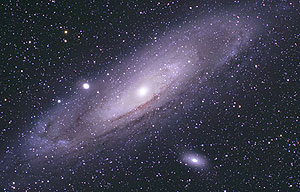 The Andromeda Galaxy, the most distant object visible
The Andromeda Galaxy, the most distant object visible
to the unaided eye. Credit: Conrad JungVery often, the term "naked eye" is used to describe what can be seen with human eyes alone, unaided by tools like telescopes, microscopes, infrared cameras, ultraviolet detectors, and so on. Back in the mid 20th Century, then director of Chabot Observatory, Earl Linsley, coined what he felt was a more accurate (and maybe less provocative?) term to describe what can be seen in the night sky with unaugmented human vision: the unaided eye.
So, without telescope or binoculars, filters or crystal balls, what are we seeing when we look at a night sky full of stars? I mean, what are we really looking at? How much of the Universe meets our unaided eyes? How far into space are we seeing?
In short, not a lot--not very far. Let's ignore the objects of our solar system for the moment--which would include the Sun, the Moon, the five "visible" planets, and the occasional comet. That leaves a multitude of individual stars and some star clusters, the ghostly arch of the Milky Way, the misty blotches of the two nearby dwarf galaxies called the Large and Small Magellanic Clouds (visible from the Southern Hemisphere), and the barely perceptible smudge of the Andromeda Galaxy.
The individual stars you can see, from the brightest beacons to those that barely tickle your dark-adapted retinas, number about 9000 across the entire sky (as seen in every direction, if the Earth were not in the way).
The closest of these, the triple star system Alpha Centauri, is about 4.3 light years away (each light year is equal to about 6 trillion miles).
